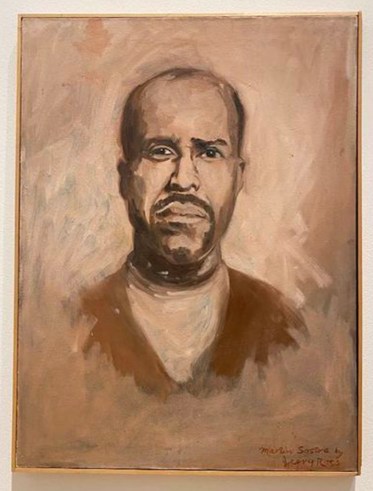Racism in America has often inspired great art from Norman Rockwell’s famous “The World We Live In,” depicting Federal marshals escorting tiny 6-year-old Ruby Bridges into William Frantz Elementary School in New Orleans to murals of George Floyd with the caption “I Can’t Breath.” The most disturbing racism is when racist police and political leaders like the brazenly racist Woodrow Wilson, Donald Trump, and Alabama Governor George Wallace exert their authority to deny black people their right to go to school, vote, eat in a diner, stay at a hotel, or to cruelly and unjustly murder, beat, or imprison.
In Buffalo, on July 15, 1967, Geraldine Robinson Pointer and Martin Sostre were arrested for selling heroin out of Sostre’s bookstore on Jefferson Ave. For its short existence, Sostre’s bookstore was a center for radical thought and education in Buffalo’s Black community. He allowed Black folks who couldn’t afford to buy books to come to the store every day to read books in the store. “This was the opportunity I had dreamed about – to be able to help my people by increasing the political awareness of the youth,” said Sostre.
From June 26 to July 1, Buffalo experienced the race riots that many cities in America were experiencing when Black people were inspired to fight racism by militant leaders like the Black Panthers and Malcolm X. Buffalo police determined that Sostre’s little bookstore needed to be shut down. They fabricated evidence and pressured a man to falsely testify that Sostre and his girlfriend, Pointer, who worked at the store, were dealing heroin and were involved in arson and rioting. They were both found guilty by an all-white jury, and Sostre was sentenced to 45 years; he spent five years in solitary confinement. Pointer was sentenced to 15 years.
Although Governor Hugh Carey granted Sostre clemency in 1975 after international pressure and petitions by prominent people, and Pointer was released after serving a little over two years, their convictions are still on their records (Sostre died in 2015). Pointer is now 80, and there is an effort to erase both of these convictions from their records, including an event by Burning Books, “Justice for Geraldine & Martin,” at the Franke E. Merriwether Library, 1324 Jefferson Ave, on August 15 at 6 pm. “I don’t want to worry about someone telling my children their mother’s a jailbird or a crook,” Pointer told the Buffalo News,.
People who are not racist recoil at the injustice served to Blacks and other minorities of color, and they respond in different ways, from protest marches, petitions, creating oversight boards, etc. Then, there are artists who express their anti-racist feelings through their art. The siblings Diane Bush (Proud “Childless Cat Lady”) and her brother Jerry Ross unexpectedly find themselves together in a new exhibit at the Burchfield-Penney, The Unseen, running July 12 -October 27, 2024.
Diane Bush’s piece is the satirical flag made out of cat hair, titled MAKE A MERKIN GREAT AGAIN, and her brother Jerry Ross has his portrait of Martin Sostre included in the exhibition.
Jerry Ross (also née Gross) was one of the famous Buffalo Nine, an anti-Vietnam War collective that gained national attention. He was also the creator and lead force behind the Free Martin Sostre Committee, which eventually achieved freedom for the unjustly jailed Sostre.
